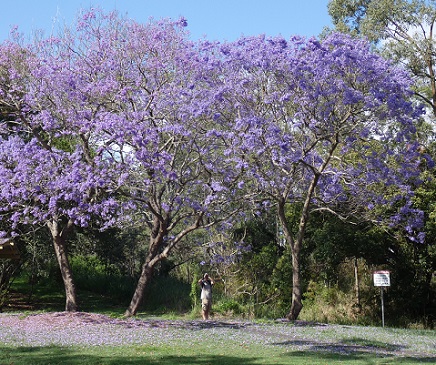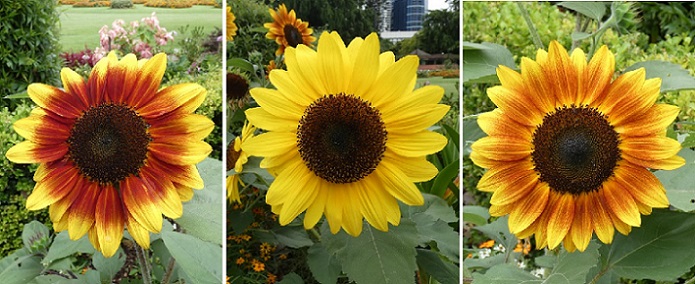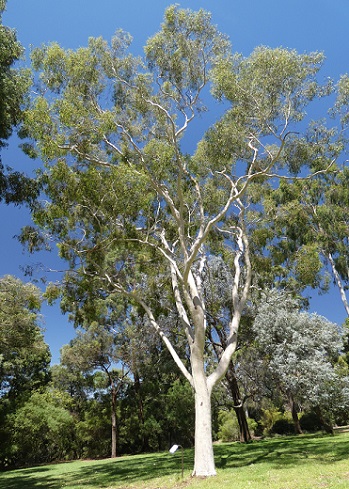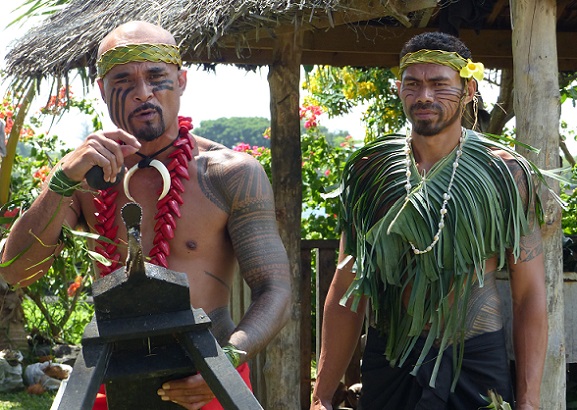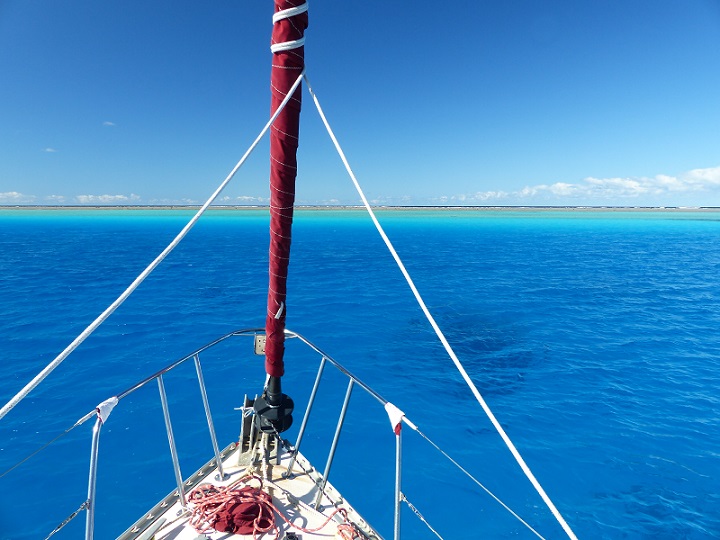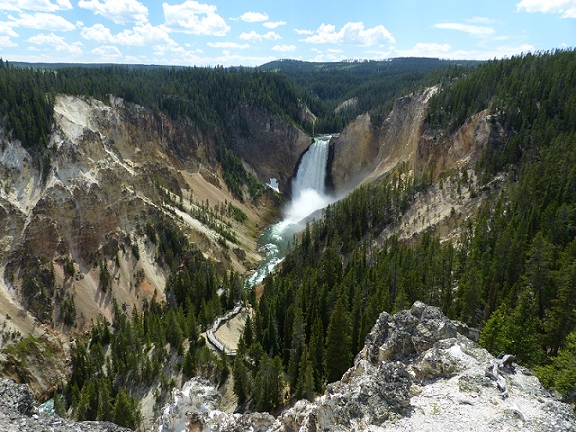
Tregoning
12 April 2024 | We are back aboard Tregoning in Mersin Marina, Mersin, Türkiye
02 April 2024 | We are in Toronto Airport, Canada: Tregoning is in Mersin Marina, Mersin, Türkiye
25 February 2024 | We are back in Gainesville, FL: Tregoning is in Mersin Marina, Mersin, Türkiye
18 February 2024 | We are in Glenwood, New Mexico: Tregoning is in Mersin Marina, Mersin, Türkiye
12 February 2024 | We are in Morro Bay, California: Tregoning is in Mersin Marina, Mersin, Türkiye
19 January 2024 | We are in Vancouver, BC Canada: Tregoning is in Mersin Marina, Mersin, Türkiye
01 January 2024 | We are in Washington State: Tregoning is in Mersin Marina, Mersin, Türkiye
15 December 2023 | We are in Minnesota: Tregoning is in Mersin Marina, Mersin, Türkiye
18 November 2023 | We are in Florida: Tregoning is in Mersin Marina, Mersin, Türkiye
29 October 2023 | We're in Florida - Tregoning is at B-dock, Mersin Marina, Mersin, Türkiye
21 October 2023 | 7 Oda Kapadokya Cave Hotel, Ürgüp, Türkiye
14 October 2023 | Hotel Aşikoğlu, Boğazkale, Türkiye
07 October 2023 | B-dock, Mersin Marina, Mersin, Türkiye
19 September 2023 | “Chez Jon & Angela”, Near Otterton, Devon, UK
14 September 2023 | Airbnb in Fortuneswell on the Isle of Portland, Dorset, UK
11 September 2023 | With Mike, Grange-over-Sands, Cumbria, UK
03 September 2023 | Ardington House, Ardington, Oxfordshire, UK
24 August 2023 | Near "Chez Joan and Peter", College of Roseisle, Moray, Scotland
11 August 2023 | Andrew's house (not exactly), Lichfield, UK
22 July 2023 | Chez Gail, near the New York Café, Budapest, Hungary
When the Sierra hits the Foxtrot*#
12 June 2017 | South end of North Minerva Reef, South Pacific Ocean
Photo: A 5-feet long (1.5 m) whitetip reef shark in North Minerva Reef
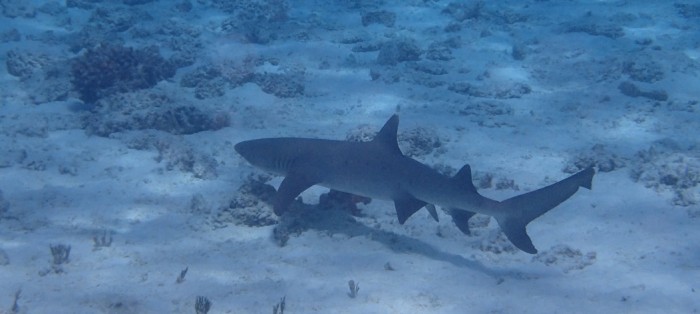
Our nine night stay in Minerva Reef was definitely worth the stop-over on our way from New Zealand to Tonga. We hope to revisit the area during another passage despite enduring near-disaster and several harrowing hours on the day before we left.
While at Minerva Reef, it was fun to spend more time with Lauri and Chuck from SV Free Spirit and we enjoyed getting to know Phil on Silhouette and Maureen and Tony on Taki Moana. The latter boat arrived on Wednesday (June 7th) the day after the rest of us had moved to the southeast quadrant of the atoll. Their engine was not working so they were going to have to sail into the pass. With the wind blowing more directly out of the pass than when Phil had done it, it seemed that assistance would be useful, just in case he could not sail in against the wind. Randall, Chuck, and Phil went to meet them in a couple of dinghies but Taki Moana did just fine.

Coral and fish (whitebar surgeonfish and convict tangs) on a part of the living reef not quite exposed at low tide
We also continued to thoroughly enjoy the snorkeling; on the bits of wreckage, on coral heads inside the reef, and on the 6 to 8 feet-high (2 m) wall on the inside of the fringing reef at the south end. While Randall became more experienced with the underwater camera, I continued to relearn the names of the species reef fish that we had seen before (more than 80 species), and to identify the satisfying dozen or so fish that were new to us. There were also several species that I could not identify from our Tropical Pacific, Reef Fish Identification book, but this is hardly surprising because in such a remote area, it is very likely that endemic biotypes (variants) have evolved.
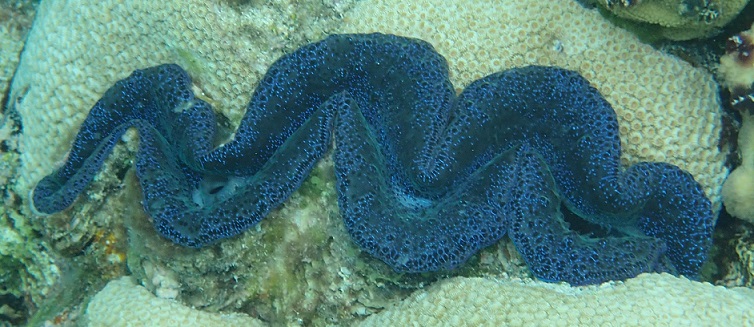
Beautiful blue lips of a giant clam (12 inches or 30 cm wide)

Grey drummer fish and a variety of coral in North Minerva Reef
Ah, yes, with a suitable weather window for us to sail to Tongatapu approaching on Monday (June 12th), everything seemed idyllic.
There was just going to be one day (of course, it turned out to be in the night) when the winds would back all the way around from southeast to east, to north, to west, and back to south, with the westerly and subsequent winds predicted to be around 20 knots. Of the four boats in the southeast quadrant of the atoll, Free Spirit and Taki Moana decided not to move. They were comfortable with a few hours of having the north winds blowing across the atoll, when the reef would not be far behind them.
We were concerned that during the anticlockwise rotation of the wind direction, our anchor chain might get caught on a coral head that lay to the southwest of us. This would not be good for the coral (and might complicate retrieving the anchor) so on Saturday morning, we moved Tregoning to the northwest quadrant of the atoll. Silhouette joined us and while Phil unsuccessfully searched for lobsters from his dinghy (with his GoPro video-camera held over the side) inside the northern part of the reef, Randall and I enjoyed a good snorkel on the large coral head behind Silhouette. This helped to make the move seem worthwhile. We should be protected from the northerly wind-waves during the night and at sunrise we would join the others back in the southeast part of the atoll, when the strengthening winds returned to a southerly direction.
Or that was the plan...
The shifting winds woke us a couple of times during the night and at 3 am we heard Maureen on the VHF radio checking that Free Spirit was in sufficiently deep water, as the northerly winds swung her closer to the reef. They were fine but by 3:30 am I found that I could no longer sleep because the strengthening winds were already coming from the west and this was creating some wind chop and plenty of noise. We were hesitant to move before dawn because we wanted to be able to look for coral heads (to avoid) when we reached the southeastern anchorage but, in retrospect, we should have moved as soon as we awoke, even if we had needed to drop the anchor temporarily in the deeper water in the middle of the atoll.
Instead, by sunrise, the wind was already above 25 knots from the south and, with the 3 nm of fetch across the atoll, this was creating 3 to 4 feet (1 m) waves. As we prepared to raise the anchor, we saw that Phil was doing the same and we were impressed that as a single-hander he could cope so well under the deteriorating conditions.
It should have been a relatively straightforward process for me to motor Tregoning slowly forward into the wind and waves, thereby taking the strain off the anchor-rode, which Randall could then raise on the windlass. However, three problems thwarted this plan and changed a relatively routine operation into a nightmarish couple of hours followed by several more anxious hours before we could eventually move to the calmer waters on the southern side of the atoll.
The first problem was that the self-tightening knot, the icicle hitch, which Randall uses to secure a snubber-line to the anchor-rode, became jammed. When anchored, the snubber-line transfers the pulling of the boat away from the windlass and onto two heavy-duty cleats on the bow. Despite being designed not to jam once the strain is released, the knot on the snubber-line had somehow acquired an extra loop which Randall could not release. The knot cannot pass through the windlass so it had to be removed before we could raise the anchor. As Randall was getting a sharp knife with which to cut this knot (but having to be really careful not to cut the underlying anchor rode, which would be a major challenge on the bucking conditions of the boat's bow), the second problem arose.
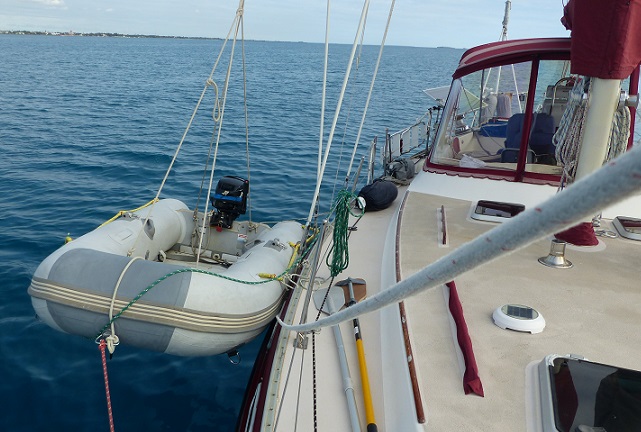
The dinghy suspended on Tregoning’s side (in good conditions)
As per usual, we had raised the dinghy out of the water for the night. It was suspended on a halyard from the top of the mast and lashed to the starboard side of Tregoning, forward of the mid-length and just below deck-level. We have moved Tregoning with the dinghy in this position before so we had not worried about trying to lift the dinghy onto the deck (difficult with the outboard on) or dropping it into the choppy water to trail behind Tregoning. As the winds increased to a steady 28 to 30 knots and the waves increased to 4 to 5 feet in height (1.5 m), the outside edge of the dinghy was repeatedly being lifted-up before dropping back to the horizontal.
Struggling to maintain his position on the bow in the wind and waves and focused on the anchor-rode and windlass, Randall had to ignore this situation, while I had to stay at the helm to shift the engine in and out of gear to reduce the strain on the anchor-rode. Eventually, the wind and waves caught the dinghy with enough force to flip it vertically on its side and hold it against the life-lines and the shrouds. Luckily, the top of the outboard engine did not bash too hard against anything and, by chance, it was lying on the approved side for horizontal storage of the motor. Unluckily, the strap that secured the plastic gasoline tank to the dinghy floor (and should have held it there even on its side) broke free from the floor-board and at some point it tumbled out of the dinghy, broke the hose to the outboard, and then drifted away. I did not see this happen, not that there was much that I could have done from Tregoning even if I had, nor did I see the oar from the top side of the dinghy come loose and float away. Seeing that the dinghy was more stable on its side, Randall so lashed it to the life-line and shrouds. Even though the dinghy now created a small sail to swing Tregoning around even more in the wind, at least the dinghy and outboard seemed to be secure.
After persistent but uncomfortable effort, Randall did manage to release the snubber-line and was able to start pulling the anchor-rode into the windlass. With gusts now reaching 42 knots, at some point, the strain on the windlass was too much and it tripped the circuit-breaker for the boat's power system. While Randall came back to the engine-room to reset the breaker (I have now learned which one it is) the windlass started to feed-out more line (a deliberate default to prevent excess strain from simply breaking the windlass). When Randall returned to the bow, he was able to tighten the capstan and stop this but we were now closer to the reef behind us and in 15 rather than 30 feet of water (5 instead of 9 m). Needless to say, I found this increasing proximity to the reef rather alarming.
I was starting to think that maybe we should tie a float to the anchor-rode and then cut that rope. We would motor away leaving the anchor, chain, and rope-rode on the bottom but we would come back when conditions improved to retrieve them. The problem with this was that it was impossible for Randall to get a float securely attached to the rope-rode, so that it would not be at risk of being swept free in the rough conditions. We would also have to anchor for a night (or two), until it calmed down sufficiently to return to the site, using a secondary anchor and only rope-rode, which in strong winds and in an area with coral-heads is not a very encouraging prospect. Instead, Randall was grimly determined to keep working on raising the anchor.
Once Randall was able to start pulling anchor-rode into the windlass, the third problem became apparent when the windlass was unable to strip the rope off the capstan. This meant that the windlass would quickly jam-up if he did not pull the rope off by hand. So lying on the bow, with one had operating the windlass button, and the other stripping rope off the capstan, poor Randall had to endure the wind and waves washing over him.
Of course, he was in no position to give me any signals so I had to guess when to increase the throttle to help reduce strain on the anchor-rode. This was safe to do when I could see the rode stretched out on one side of the bow or the other (and the wind tended to push Tregoning in a wide arc to either side of the anchor) but if I could not see the line beyond Randall and Tregoning's bow, I had to reduce power. The worst thing that could happen in all of this would have been to motor forward too far and get the anchor-rode caught on Tregoning's propeller. That would create the potential for being ship-wrecked on the reef if either the anchor or rode failed before we could get it untangled from the propeller. Untangling would be impossible with the hull's rapid motion in the waves and under the existing strain on the anchor-rode. Additionally, the strain of the rode on the propeller would probably bend and damage the propeller-shaft beyond practical use.
Despite all of these limitations, Randall was gradually making progress in pulling-in the rope part of the anchor-rode. However, while he was trying to flip the rode off the spare anchor roller (where a large wave had deposited it), his right hand was suddenly jammed between the taut rope and the capstan of the windlass. It is incredible that he did not lose or break any of his fingers while the full force of the boat on the anchor-rode crushed them into the capstan but eventually he was able to reach the "down" button of the windlass and pay the rope, and his hand, out of the capstan.
I was mercifully oblivious of all of this until he crawled back to the cockpit cradling his hand and I saw the blood trickling from the multiple cuts on each finger. He could slowly bend each finger enough to suggest that they were not badly fractured but it was obvious that they would swell-up and the bruising would be horrible. We discussed the option of cutting ourselves loose but after a few minutes of studying his injuries and deciding that he did not like the other options, Randall bravely returned to the bow and continued gradually pulling-in the rode.
After painstaking effort, Tregoning was finally pulled-up to the chain part of the rode (150 feet or 45 m from the anchor). With the bow still pounding up and down and no give in the extended chain (unlike the rope which can stretch a bit), Randall needed the chain hook and it's snubber-line to help ease the impact on the bow in big waves. By the time he returned to the bow after retrieving the chain-hook, however, a big wave had caused the windlass to start releasing line again. Once more, Randall tightened the capstan and at this point we were back to the same amount of rode that we had started with.
Although the wind was not easing much, it did not seem to be getting any stronger, so we decided to stop trying to raise the anchor. Randall attached the snubber-line and then, while I kept the engine running and watched our position on the chart-plotter, he went down to the salon and slept. During the first part of the two hours or so that we had been struggling, Phil had hung around in Silhouette waiting to see if we needed help. Realizing that there was not much that he could do and that we did not seem to be heading towards the reef, he slowly made his way to the south end of the atoll. Once we had decided to wait until the winds calmed a bit more, I called him and reported on our situation. He then called us every 30 minutes to check that all was well, which was very comforting.
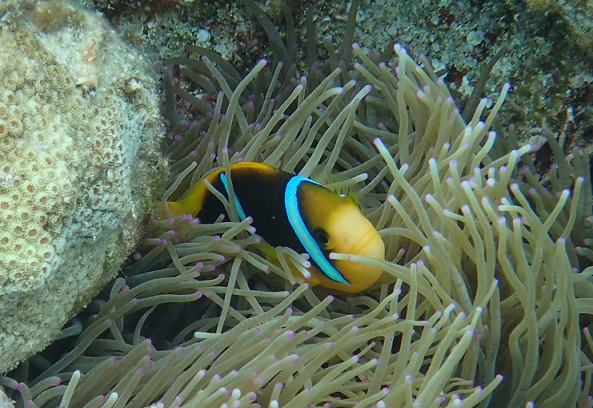
An orange-finned anemonefish beside an anemone at North Minerva Reef
After four hours of swinging and bouncing around on the anchor, the wind had finally diminished enough for us to consider trying again. After coping with greater than 30 knot conditions, 20 to 25 knot winds seemed almost benign. This is quite remarkable given that they would normally be strong enough to induce some anxiety when at anchor. With the reduced winds and slightly lower waves, the whole process of raising the anchor reverted to its usual simplicity, with Randall able to stand and give me clear hand-signals about when to power forward or go into neutral gear. The windlass worked normally and Randall did not have to put his now-bandaged hand at risk.
After slowly making our way across the atoll into the headwind, we were very happy to re-anchor close to our friends and away from any coral-heads. After further naps, we unlashed the dinghy, dropped it in the water and removed the outboard, then raised it up on the deck, deflated it, and stowed it below for the passage to Tonga. This was all done in 15 to 20 knot winds but, without any waves, it was quite manageable. Even if we did not leave the next day as intended, a dinghy without a functioning outboard (we did not have a spare fuel tank and hose) and with only one oar was not going to be of any use in the forecast winds of 15 to 20 knots. Needless to say, after a day that had such an exhausting and anxious start, we both slept very deeply that night.

Yellowfin goatfish pour over the coral at the south end of North Minerva Reef
*Phil on SV Silhouette came up with this expression which uses the phonetic alphabet of Sierra for S and Foxtrot for F
# If this still does not mean anything to you: there is a rather crude expression in the US for when things get really serious (usually going wrong) "When the s**t hits the fan"
While at Minerva Reef, it was fun to spend more time with Lauri and Chuck from SV Free Spirit and we enjoyed getting to know Phil on Silhouette and Maureen and Tony on Taki Moana. The latter boat arrived on Wednesday (June 7th) the day after the rest of us had moved to the southeast quadrant of the atoll. Their engine was not working so they were going to have to sail into the pass. With the wind blowing more directly out of the pass than when Phil had done it, it seemed that assistance would be useful, just in case he could not sail in against the wind. Randall, Chuck, and Phil went to meet them in a couple of dinghies but Taki Moana did just fine.

Coral and fish (whitebar surgeonfish and convict tangs) on a part of the living reef not quite exposed at low tide
We also continued to thoroughly enjoy the snorkeling; on the bits of wreckage, on coral heads inside the reef, and on the 6 to 8 feet-high (2 m) wall on the inside of the fringing reef at the south end. While Randall became more experienced with the underwater camera, I continued to relearn the names of the species reef fish that we had seen before (more than 80 species), and to identify the satisfying dozen or so fish that were new to us. There were also several species that I could not identify from our Tropical Pacific, Reef Fish Identification book, but this is hardly surprising because in such a remote area, it is very likely that endemic biotypes (variants) have evolved.

Beautiful blue lips of a giant clam (12 inches or 30 cm wide)

Grey drummer fish and a variety of coral in North Minerva Reef
Ah, yes, with a suitable weather window for us to sail to Tongatapu approaching on Monday (June 12th), everything seemed idyllic.
There was just going to be one day (of course, it turned out to be in the night) when the winds would back all the way around from southeast to east, to north, to west, and back to south, with the westerly and subsequent winds predicted to be around 20 knots. Of the four boats in the southeast quadrant of the atoll, Free Spirit and Taki Moana decided not to move. They were comfortable with a few hours of having the north winds blowing across the atoll, when the reef would not be far behind them.
We were concerned that during the anticlockwise rotation of the wind direction, our anchor chain might get caught on a coral head that lay to the southwest of us. This would not be good for the coral (and might complicate retrieving the anchor) so on Saturday morning, we moved Tregoning to the northwest quadrant of the atoll. Silhouette joined us and while Phil unsuccessfully searched for lobsters from his dinghy (with his GoPro video-camera held over the side) inside the northern part of the reef, Randall and I enjoyed a good snorkel on the large coral head behind Silhouette. This helped to make the move seem worthwhile. We should be protected from the northerly wind-waves during the night and at sunrise we would join the others back in the southeast part of the atoll, when the strengthening winds returned to a southerly direction.
Or that was the plan...
The shifting winds woke us a couple of times during the night and at 3 am we heard Maureen on the VHF radio checking that Free Spirit was in sufficiently deep water, as the northerly winds swung her closer to the reef. They were fine but by 3:30 am I found that I could no longer sleep because the strengthening winds were already coming from the west and this was creating some wind chop and plenty of noise. We were hesitant to move before dawn because we wanted to be able to look for coral heads (to avoid) when we reached the southeastern anchorage but, in retrospect, we should have moved as soon as we awoke, even if we had needed to drop the anchor temporarily in the deeper water in the middle of the atoll.
Instead, by sunrise, the wind was already above 25 knots from the south and, with the 3 nm of fetch across the atoll, this was creating 3 to 4 feet (1 m) waves. As we prepared to raise the anchor, we saw that Phil was doing the same and we were impressed that as a single-hander he could cope so well under the deteriorating conditions.
It should have been a relatively straightforward process for me to motor Tregoning slowly forward into the wind and waves, thereby taking the strain off the anchor-rode, which Randall could then raise on the windlass. However, three problems thwarted this plan and changed a relatively routine operation into a nightmarish couple of hours followed by several more anxious hours before we could eventually move to the calmer waters on the southern side of the atoll.
The first problem was that the self-tightening knot, the icicle hitch, which Randall uses to secure a snubber-line to the anchor-rode, became jammed. When anchored, the snubber-line transfers the pulling of the boat away from the windlass and onto two heavy-duty cleats on the bow. Despite being designed not to jam once the strain is released, the knot on the snubber-line had somehow acquired an extra loop which Randall could not release. The knot cannot pass through the windlass so it had to be removed before we could raise the anchor. As Randall was getting a sharp knife with which to cut this knot (but having to be really careful not to cut the underlying anchor rode, which would be a major challenge on the bucking conditions of the boat's bow), the second problem arose.

The dinghy suspended on Tregoning’s side (in good conditions)
As per usual, we had raised the dinghy out of the water for the night. It was suspended on a halyard from the top of the mast and lashed to the starboard side of Tregoning, forward of the mid-length and just below deck-level. We have moved Tregoning with the dinghy in this position before so we had not worried about trying to lift the dinghy onto the deck (difficult with the outboard on) or dropping it into the choppy water to trail behind Tregoning. As the winds increased to a steady 28 to 30 knots and the waves increased to 4 to 5 feet in height (1.5 m), the outside edge of the dinghy was repeatedly being lifted-up before dropping back to the horizontal.
Struggling to maintain his position on the bow in the wind and waves and focused on the anchor-rode and windlass, Randall had to ignore this situation, while I had to stay at the helm to shift the engine in and out of gear to reduce the strain on the anchor-rode. Eventually, the wind and waves caught the dinghy with enough force to flip it vertically on its side and hold it against the life-lines and the shrouds. Luckily, the top of the outboard engine did not bash too hard against anything and, by chance, it was lying on the approved side for horizontal storage of the motor. Unluckily, the strap that secured the plastic gasoline tank to the dinghy floor (and should have held it there even on its side) broke free from the floor-board and at some point it tumbled out of the dinghy, broke the hose to the outboard, and then drifted away. I did not see this happen, not that there was much that I could have done from Tregoning even if I had, nor did I see the oar from the top side of the dinghy come loose and float away. Seeing that the dinghy was more stable on its side, Randall so lashed it to the life-line and shrouds. Even though the dinghy now created a small sail to swing Tregoning around even more in the wind, at least the dinghy and outboard seemed to be secure.
After persistent but uncomfortable effort, Randall did manage to release the snubber-line and was able to start pulling the anchor-rode into the windlass. With gusts now reaching 42 knots, at some point, the strain on the windlass was too much and it tripped the circuit-breaker for the boat's power system. While Randall came back to the engine-room to reset the breaker (I have now learned which one it is) the windlass started to feed-out more line (a deliberate default to prevent excess strain from simply breaking the windlass). When Randall returned to the bow, he was able to tighten the capstan and stop this but we were now closer to the reef behind us and in 15 rather than 30 feet of water (5 instead of 9 m). Needless to say, I found this increasing proximity to the reef rather alarming.
I was starting to think that maybe we should tie a float to the anchor-rode and then cut that rope. We would motor away leaving the anchor, chain, and rope-rode on the bottom but we would come back when conditions improved to retrieve them. The problem with this was that it was impossible for Randall to get a float securely attached to the rope-rode, so that it would not be at risk of being swept free in the rough conditions. We would also have to anchor for a night (or two), until it calmed down sufficiently to return to the site, using a secondary anchor and only rope-rode, which in strong winds and in an area with coral-heads is not a very encouraging prospect. Instead, Randall was grimly determined to keep working on raising the anchor.
Once Randall was able to start pulling anchor-rode into the windlass, the third problem became apparent when the windlass was unable to strip the rope off the capstan. This meant that the windlass would quickly jam-up if he did not pull the rope off by hand. So lying on the bow, with one had operating the windlass button, and the other stripping rope off the capstan, poor Randall had to endure the wind and waves washing over him.
Of course, he was in no position to give me any signals so I had to guess when to increase the throttle to help reduce strain on the anchor-rode. This was safe to do when I could see the rode stretched out on one side of the bow or the other (and the wind tended to push Tregoning in a wide arc to either side of the anchor) but if I could not see the line beyond Randall and Tregoning's bow, I had to reduce power. The worst thing that could happen in all of this would have been to motor forward too far and get the anchor-rode caught on Tregoning's propeller. That would create the potential for being ship-wrecked on the reef if either the anchor or rode failed before we could get it untangled from the propeller. Untangling would be impossible with the hull's rapid motion in the waves and under the existing strain on the anchor-rode. Additionally, the strain of the rode on the propeller would probably bend and damage the propeller-shaft beyond practical use.
Despite all of these limitations, Randall was gradually making progress in pulling-in the rope part of the anchor-rode. However, while he was trying to flip the rode off the spare anchor roller (where a large wave had deposited it), his right hand was suddenly jammed between the taut rope and the capstan of the windlass. It is incredible that he did not lose or break any of his fingers while the full force of the boat on the anchor-rode crushed them into the capstan but eventually he was able to reach the "down" button of the windlass and pay the rope, and his hand, out of the capstan.
I was mercifully oblivious of all of this until he crawled back to the cockpit cradling his hand and I saw the blood trickling from the multiple cuts on each finger. He could slowly bend each finger enough to suggest that they were not badly fractured but it was obvious that they would swell-up and the bruising would be horrible. We discussed the option of cutting ourselves loose but after a few minutes of studying his injuries and deciding that he did not like the other options, Randall bravely returned to the bow and continued gradually pulling-in the rode.
After painstaking effort, Tregoning was finally pulled-up to the chain part of the rode (150 feet or 45 m from the anchor). With the bow still pounding up and down and no give in the extended chain (unlike the rope which can stretch a bit), Randall needed the chain hook and it's snubber-line to help ease the impact on the bow in big waves. By the time he returned to the bow after retrieving the chain-hook, however, a big wave had caused the windlass to start releasing line again. Once more, Randall tightened the capstan and at this point we were back to the same amount of rode that we had started with.
Although the wind was not easing much, it did not seem to be getting any stronger, so we decided to stop trying to raise the anchor. Randall attached the snubber-line and then, while I kept the engine running and watched our position on the chart-plotter, he went down to the salon and slept. During the first part of the two hours or so that we had been struggling, Phil had hung around in Silhouette waiting to see if we needed help. Realizing that there was not much that he could do and that we did not seem to be heading towards the reef, he slowly made his way to the south end of the atoll. Once we had decided to wait until the winds calmed a bit more, I called him and reported on our situation. He then called us every 30 minutes to check that all was well, which was very comforting.

An orange-finned anemonefish beside an anemone at North Minerva Reef
After four hours of swinging and bouncing around on the anchor, the wind had finally diminished enough for us to consider trying again. After coping with greater than 30 knot conditions, 20 to 25 knot winds seemed almost benign. This is quite remarkable given that they would normally be strong enough to induce some anxiety when at anchor. With the reduced winds and slightly lower waves, the whole process of raising the anchor reverted to its usual simplicity, with Randall able to stand and give me clear hand-signals about when to power forward or go into neutral gear. The windlass worked normally and Randall did not have to put his now-bandaged hand at risk.
After slowly making our way across the atoll into the headwind, we were very happy to re-anchor close to our friends and away from any coral-heads. After further naps, we unlashed the dinghy, dropped it in the water and removed the outboard, then raised it up on the deck, deflated it, and stowed it below for the passage to Tonga. This was all done in 15 to 20 knot winds but, without any waves, it was quite manageable. Even if we did not leave the next day as intended, a dinghy without a functioning outboard (we did not have a spare fuel tank and hose) and with only one oar was not going to be of any use in the forecast winds of 15 to 20 knots. Needless to say, after a day that had such an exhausting and anxious start, we both slept very deeply that night.

Yellowfin goatfish pour over the coral at the south end of North Minerva Reef
*Phil on SV Silhouette came up with this expression which uses the phonetic alphabet of Sierra for S and Foxtrot for F
# If this still does not mean anything to you: there is a rather crude expression in the US for when things get really serious (usually going wrong) "When the s**t hits the fan"
Comments
| Vessel Name: | Tregoning |
| Vessel Make/Model: | Morgan Classic 41 |
| Hailing Port: | Gainesville, FL |
| Crew: | Alison and Randall |
| About: | We cast-off from Fernandina Beach in north Florida on 1st June 2008 and we have been cruising on Tregoning ever since. Before buying Tregoning, both of us had been sailing on smaller boats for many years and had worked around boats and water throughout our careers. |
| Extra: | “Tregoning” (rhymes with “belonging”) and is a Cornish word (meaning “homestead of Cohnan” or “farm by the ash trees”) and was Alison's mother’s middle name. Cornwall is in southwest England and is where Alison grew-up. |
Tregoning's Photos - Main
 |
Extra photographs from our three-week campervan tour of the South Island from November 15th to December 5th 2015
217 Photos
Created 4 January 2016
|
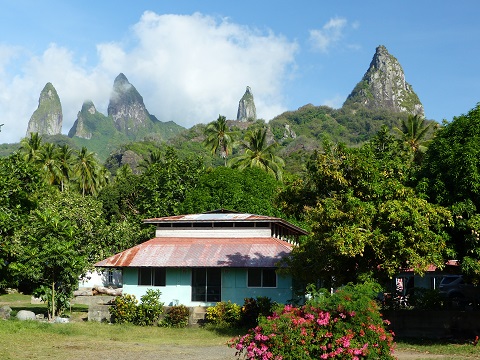 |
Random pictures from our month spent on the islands of Hiva Oa, Tahuata, Ua Pou, and Nuku Hiva
45 Photos
Created 18 July 2015
|
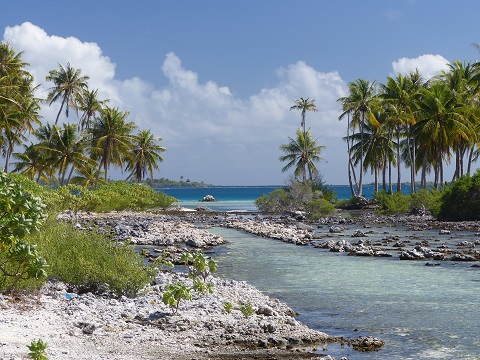 |
Random pictures from our month spent in 4 Tuamotu Atolls; Ahe, Fakarava, Tahanea, and Toau
32 Photos
Created 1 July 2015
|
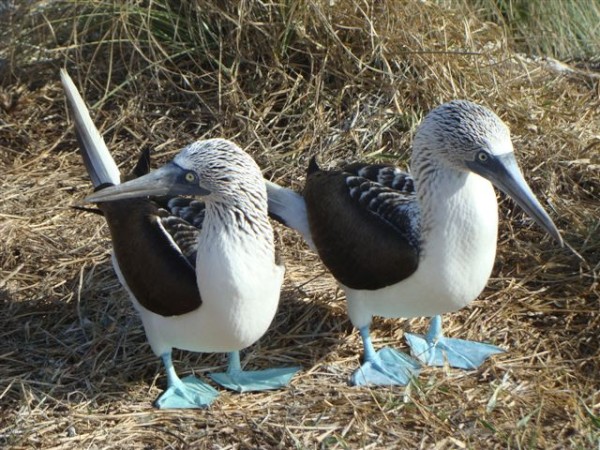 |
Some of the birds, fish, reptiles, and mammals (and others) that we have seen in Mexico
74 Photos
Created 5 May 2014
|
Tregoning

Who: Alison and Randall
Port: Gainesville, FL





